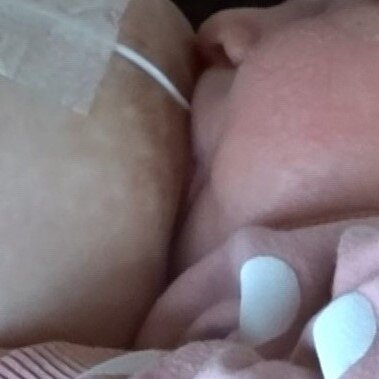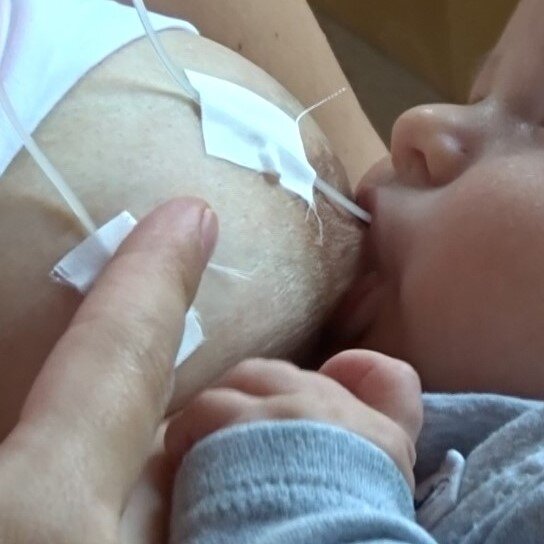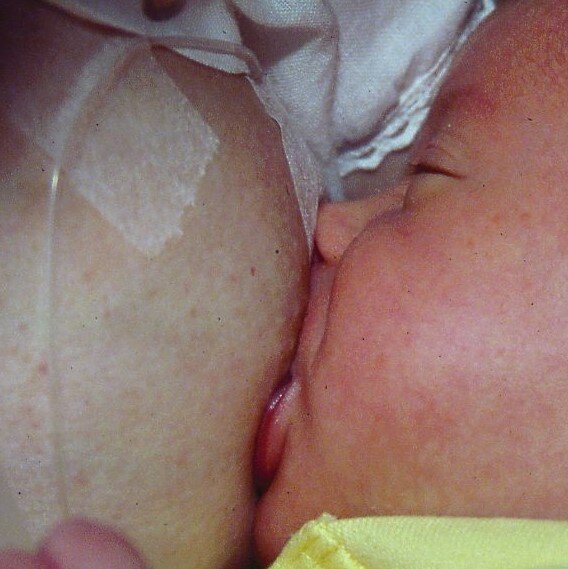The second phase - some changes are Essential
The early days with at-breast supplementation are behind you - it’s time for some changes. The first phase involves your first attempts with at-breast supplementation. As soon as you have some confidence in at-breast supplementation, the second phase begins. What was appropriate at the beginning - to make breastfeeding with an at-breast supplementer as easy as possible - is no longer helpful. Two main changes are essential for preparing a smoothless weaning from the device.
A good latch is now very important
In the beginning, any latch is acceptable for a short period while your baby is getting used to this new way of feeding. But for the long haul, an effective attachment to the breast as soon as possible is the goal. Paying attention to how your baby suckles and reattach your baby - if needed - is your job as mother.
The baby on the left is too far away from the breast, the baby in the middle and right are very near to the breast. Therefore, hold your baby VERY CLOSELY so that your baby has a lot of breast tissue in his mouth.
It is important now to improve the way how you attach your baby to the breast. An asymmetric latching technique can be very useful to reach an intensive latch. You can experiment with the two possibilities to attach your baby at the breast with a tube.
Simulate the time needed for the milk ejection reflex
In the beginning you adjusted the at-breast supplementer in such a way that the milk flowed abundantly from the first second for encouraging your baby. This is now no longer appropriate. The exclusively breastfed baby only gets a small amount of mother’s milk at the beginning of a breastfeed until the milk ejection reflex is set off. Only then does the milk flow abundantly. Now it’s time to gradually introduce your baby to the pattern he / she can expect with exclusive breastfeeding.
For that it is important that you first begin WITHOUT flow from the at-breast supplementer and only SOMEWHAT LATER make the milk flow from the device possible. There are different ways to do that:
Keep the tube closed during the first minutes of the breastfeed.
Breastfeed your baby on the left side without tube for a few minutes, then on the right side without tube, meanwhile you hang the device on the hook and tape the tube on the left side. Then you breastfeed with tube on the left side, tape the tube on the right side and end breastfeeding with tube on the right side.
This approach prevents that the baby would not latch without tube. Gradually the time at the breast without tubes can become longer.
Breastfeeding and supplementation frequency
If your goal is exclusive breastfeeding, it is normal that you breastfeed 8-12 times per day but not with at-breast supplementation each time. It is advantageous to space out the necessary supplementation in more frequent smaller portions - for example 6-8 times per day.
Preparing the formula in the Supplemental Nursing System
After having prepared formula in another container in the beginning, you can now save time by preparing formula in the SNS:
Pour boiled water into the SNS
Measure the amount of powder and put it into the SNS (it is useful to use a funnel)
Fill with water up to the designated amount
Screw on the yellow attachment ring of the SNS, close the tubes
First shake carefully crossways and then firmly
Test the flow (see video Supplemental Nursing System Preparation)
What helps you to keep at it?
In order to achieve your wish to breastfeed, you need some perseverence. What is helpful for you? Which people support you practically and with encouraging words? What tasks and plans can you postpone until later? Perhaps there is something which helps you to achieve inner calm, to stay in touch with yourself and to enjoy your baby.
Only you can feel what is in harmony with your baby and your family.
The third phase - Slowly Tapering off at-breast supplementation
When your baby’s weight gain has caught up and/or your milk supply has increased, the time is gradually ripe for tapering off the at-breast supplementer. You will see this when your baby’s weight gain is appropriate for his age (you will receive feedback in the breastfeeding counselling), when he has ample (wet/dirty) diapers, is mostly contented and begins no longer drinking all that is available in the nursing supplementer. Thereby, the baby drives the tapering off of the tube-feeding device. Now a slower flow for as long and as intensive sucking makes sense as does breastfeeding without the device. Here, too, “slower is mostly faster” and it is helpful to follow the baby’s rhythm.
Some nursing couples can completely leave off at-breast supplementation and arrive at exclusive breastfeeding. Others use the device longer. The amount of supplement is less, but some supplementation is still necessary, mostly until the start of solid foods and somewhat past that. Later on, mother and baby are happy that they can continue breastfeeding – without any device – while to the child eats more and more from the family meals.
Further information
Helpful for at-breast supplementation are some Important details & further information
Back to the Overview At-breast supplementation
© 2020 Márta Guóth-Gumberger. All rights reserved.



